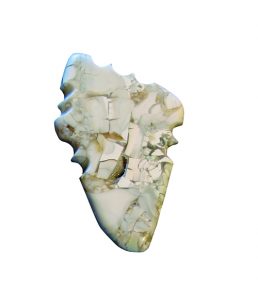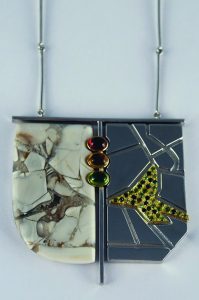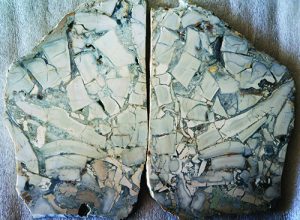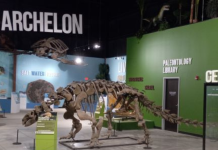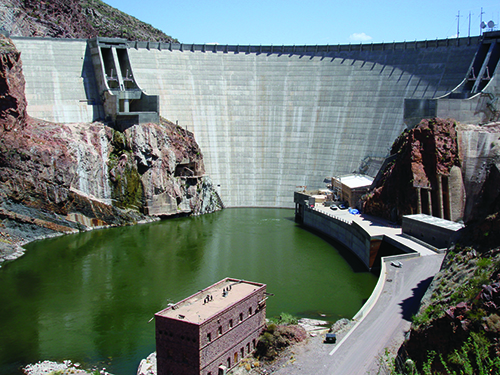
By Helen Serras-Herman
The Roosevelt Dam agate is a very limited-occurrence lapidary material, uncovered during the excavation of the Theodore Roosevelt Dam in Arizona, hence the obvious name of Roosevelt Dam agate.
The Theodore Roosevelt Dam is located on the Salt River, northeast of Phoenix. The masonry dam was built between 1905 and 1911 and was renovated and expanded between 1989 and 1996. The dam is 357 feet high, with a hydroelectric generating capacity of 36,000kW. It was the first major project under the new federal law of 1902 – the Reclamation Act – which paved the way for irrigation projects to aid the arid western states’ settlement.
The dam sits at the confluence of Tonto Creek and the Salt River. The location of this narrow gorge was initially called “The Crossing” by early Arizona pioneers. It was the place on the Salt River where Native Americans, farmers, and ranchers would ford the river. The dam forms the artificial 21,500-acre Theodore Roosevelt Lake. The project’s primary purpose was to provide water storage and flood control through the Salt River Valley.
The dam is named after U.S. President Theodore Roosevelt, who dedicated the dam on March 18, 1911. During the dedication speech, Roosevelt said that his administration’s two proudest achievements were the Reclamation Act and the Panama Canal.
In 1963, the Roosevelt Dam became a National Historic Landmark, but that status was withdrawn in 1999, as the 1989 modifications had altered the original design’s integrity.
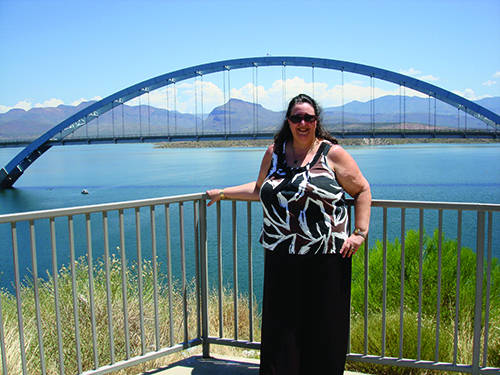
When my husband and I visited the area, we made a stop at the Roosevelt Dam and took in the imposing view. From the overlook, you can enjoy a closer view of the engineering wonder. Interpretive signs share history with visitors. There is a historic red sandstone building on site, once the home of the Bureau of Reclamation. Also visible is the two-mile-long Roosevelt Lake Bridge. To relocate traffic from traveling atop the Roosevelt dam, a steel arch bridge, Roosevelt Lake Bridge, opened in 1992. The bridge was painted blue to blend with the lake and sky.
More history about the area appears in informative exhibits within and surrounding the Roosevelt Lake Visitor Center. Also available are maps, passes, and permits. The lake offers various wildlife, nature, and bird-watching opportunities, besides all the water’s recreational activities.
Roosevelt Dam Agate
During our visit, we followed the historic Apache Trail and reached the copper mining town of Globe. In this historic community, we found The Copper City Rock Shop, a wonderful shop jam-packed inside and out with minerals, lapidary rock and slabs, mineral ore specimens, and fossils. The shop also has a nice inventory of local gem materials, including the nearby-mined peridot and Arizona turquoise. Looking around the shop, I came across a few slabs of a material I had never seen before, which the shop owner called Roosevelt Dam agate. According to the owner, these slabs came from a few rare specimens uncovered during the dam’s excavation, possibly during the dam’s renovation in the 1990s.
I found the material very interesting and cut several of the slabs into carvings and cabochons. Roosevelt Dam agate is a brecciated hard agate composed of small, angular fragments of agate and jasper embedded in a fine-grained matrix. Some arched fragments fan out in multiple directions, giving a beautiful movement to the scenery. The color of these slabs is stark white to grayish, and they are interspersed with beautiful small pockets of drusy quartz and golden translucent agate veinlets. Brecciated materials are nature’s mosaics, a conglomerate of colors and textures.
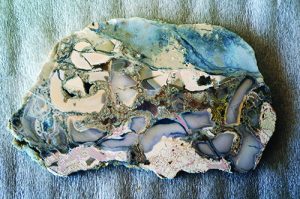
Roosevelt Dam agate is somewhat similar to Burro Creek pastelite, a type of chert or jasper found at Burro Creek, 14 miles southeast of Wikieup in Mohave County, Arizona. Burro Creek is a favorite rockhounding location, famous for its solid purple agate, sometimes with black dendrites. Pastelite is also a brecciated variety but, true to its name, it occurs in pastel colors of pink, peach, and gray, unlike the mostly stark white Roosevelt Dam agate. Also, the Roosevelt Dam agate is more compact than pastelite, with a less soft matrix in between the agate.
Getting to Roosevelt Dam
As I mentioned, we made our way to Roosevelt Dam along the Historic Apache Trail, a loop road covering some of the most rugged terrain in Arizona. Breathtaking views of steep-sided canyons, glorious geological formations, and three beautiful lakes are all hidden treasures along this scenic road that starts at Apache Junction, east of Phoenix, and heads 180 degrees east to Globe.
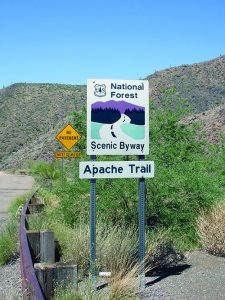
The road continues past historic Tortilla Flats, but should you remain onwards to Apache Lake and the Roosevelt Dam, be prepared and forewarned about the washboard dirt road, the hairpin curves and switchbacks in steep downhill drops, and then back uphill until you reach the Roosevelt Dam. The road is often packed with boat trailers and RV campers going to and from the lakes, but the magnificent views will reward you. While driving, reflect on the fact that the Apache Trail road, which was built as a supply road for the Roosevelt Dam, was a great improvement compared to the pre-1906 Yavapai trail that connected the Tonto Basin and the Salt River Valley. The average speed on this road is 20 mph, and it took us over an hour to navigate the 14 miles from Tortilla Flat to the Apache Lake Marina & Resort, where we stayed the night. An equally gruesome trip of another 20 miles awaits from Apache Lake to Roosevelt Lake and Dam.
Two alternative and easier, all-paved routes can take you to Roosevelt Dam. First, from Mesa in east Phoenix, take State Hwy 87 north for about 60 miles and turn right on State Hwy 188. Follow the road for 26 miles to Roosevelt Lake at mile-marker 242.8. Additionally, you can drive up from Globe, following State Hwy 188 for 27 miles.
Author: Helen Serras-Herman
 Helen Serras-Herman, a 2003 National Lapidary Hall of Fame inductee, is an acclaimed gem sculptor and gemologist with over 37 years of experience in unique gem sculpture and jewelry art. Visit her website at www.gemartcenter.com and her business Facebook page at Gem Art Center/Helen Serras-Herman.
Helen Serras-Herman, a 2003 National Lapidary Hall of Fame inductee, is an acclaimed gem sculptor and gemologist with over 37 years of experience in unique gem sculpture and jewelry art. Visit her website at www.gemartcenter.com and her business Facebook page at Gem Art Center/Helen Serras-Herman.
If you enjoyed what you’ve read here we invite you to consider signing up for the FREE Rock & Gem weekly newsletter. Learn more>>>
In addition, we invite you to consider subscribing to Rock & Gem magazine. The cost for a one-year U.S. subscription (12 issues) is $29.95. Learn more >>>


